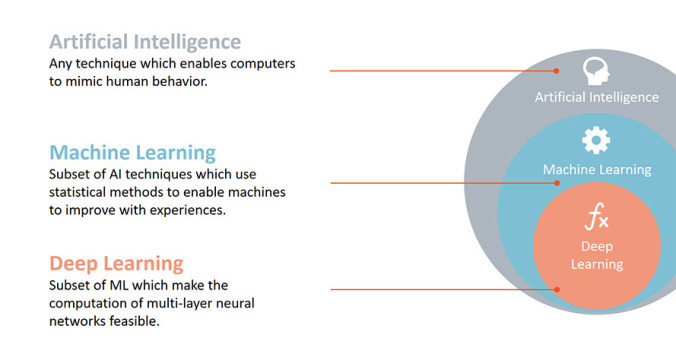
Artificial Intelligence has been a buzz word in martech. Many martech vendors position their products as AI-based platforms. What does that mean? As a marketer, what do you need to know about AI to evaluate vendors’ platforms to have a productive conversation with them?
Take a look at the background and ideas to get you started…
What is Artificial Intelligence?
In a simple term, machines demonstrate intelligence by mimicking human behavior. But humans exhibit “intelligence” in many different ways, such as thinking, learning, reasoning, perfecting a task, contextual decision-marketing and more. Given that humans are complex and sophisticated, it’s almost impossible to use a set of technology to build a fully functional robot or intelligent being like C3PO in the Star Wars or a Terminator at this time.
What human behaviors are emulated by AI so far?
Today, scientist tackle artificial intelligence by mimicking different aspects of human behaviors.
One approach is communications:
Can we teach computers to translate from English to Chinese? Or can we teach computers to respond to questions like a human? This focuses on verbal interactions with humans using Natural Language Processing (NLP). Google Home and Alexa are perfect examples of teaching computers to verbally respond to human inquiries and needs.
Another approach is task completion or situational decision-making:
Can we teach computers to perform complex tasks repeatedly and make decisions based on syntax, perceptions, and reasoning in the context of specific situations? The best examples are playing complex games such as Go or Chess, driving a car or delivering a parcel. Rather than building rules into computers, scientists take the approach of building algorithms to help computers learn how to perform and improve at tasks. This ‘machine learning’ doesn’t equate to AI, it’s a subset of AI. A further subset of machine learning which has entered the mainstream, ‘deep learning,’ involves building a layered structure of algorithms called an artificial neural network (ANN).
This is modeled on the biological neural network of the human brain. Then, users can feed a massive amount of data into the neural network to help a computer learn. By doing so for many rounds of learning cycles, like humans, computers get better and better at recognizing patterns, understanding how to respond to different situations. Hopefully, they can make the right decisions on their own based on context.
Here is the tricky part: The deep learning approach is largely based on opaque algorithms that make decisions even their own designers may be unable to explain. What if machines do something unexpected or initiative a series of ‘wrong’ behaviors which may harm humans? That’s one of the reasons that many scientists, including late Stephen Hawking, are concerned about the future of AI development.
The other approach is to use AI to make recommendations:
What about using AI to anticipate users’ needs or improve predictive and prescribe analytics? Google uses machine learning techniques to crawl millions of data points to accurately respond to the user’s questions. Spotify and iTunes are constantly learning our music listening preferences and recommending what we may want to listen to next. Based on our buying patterns, Amazon’s system learns and suggests what we may want to buy next.
With all the examples I mentioned, AI is already here as part of our lives, yet there is so much more we can do with AI.
Source: Rapidminder Blog
If you are interested in the history of AI, check out the evolution of AI:
A brief history of Artificial Intelligence by BootstrapLabs (3:00)
AI, Deep Learning, and Machine Learning: A Primer (video) (46:00)
Timeline of Computer History: AI & Robotics by Computer History Museum
How can AI help sales and marketing?
Before you can answer that question, you need to understand what you want from AI. Here are some ways that AI can help sales and marketing:
1. Automate existing sales or marketing tasks
Conversica, an AI-powered sales assistant, can send out emails and interpret the responses to determine if potential leads are hot. The sales assistant, powered by AI through machine learning, can understand most of the emails she receives; the email that she can’t understand is sent to her human manager. Then she routes the right leads to the right reps. She’ll even set appointments for the appropriate salesperson and seamlessly hands-off those leads.
2. Customize and personalize copywriting, content creation, and distribution
CoSchedule, a suite of social media scheduling tools, allows you to add your social messages to ReQueue (with built-in intelligence). It will take into account your entire social schedule, uses Best Time Scheduling to promote your messages at the most optimal times and finds gaps in your schedule (so you don’t have to).
3. Reveal why deals are won or lost by analyzing sales calls
Chorus uses AI to record, transcribe and break down a 1-hour sales call into a 5-minute highlight by providing actionable feedback to help move a deal forward. Sales teams can further optimize their communications and ramp new hires faster.
4. Discover new leads by correlating various existing data
Most companies have email databases. It may be useful to discover any relationships between email database contacts and CRM contacts or if there are unexpected connections or relationships among different contacts in these lists.
This can help discern the different players and roles of prospects to help sales and marketing customize their outreach and enhance conversions.
In addition to using AI platforms such as Tensorflow to find patterns unrecognized by humans, companies can also build a model using Alteryx, Knime, or Rapidminer to discover new leads or uncover relationships among different prospects.
5. Replace specific human interaction or conversational activities
The perfect example of this is a chatbot such as Drift, HelpCrunch, Flow XO. Some chatbots have machine-learning algorithms built in to further refine their replies to prospects’ questions.
How do you determine if you want to use AI for your sales and marketing efforts?
To determine how AI can help you, it’s best that you have a list of questions that you want to answer. Then, you need to know where to pull relevant data which may address these questions.
The next step is to find the tools or platforms that can assist you. You’ll need to do some research and talk to different vendors to understand their capabilities.
For example, if you are looking for a chatbot that resides on your website, Drift is a great option. If you are looking to build customized chatbots across a wide range of different sites, applications, and social media platforms, FlowXO is likely to be a better bet. Therefore, it’s important to know what you want to resolve or address. That understanding will guide your discussions with vendors.
In addition, it’s also essential to understand how the question you want to address fits into the overall sales and marketing processes. Ultimately, you need to be able to quantify the productivity, cost savings, or the impact on revenue.
Although no one is building a robot marketer (yet), AI, as a form of virtual marketing assistant or sales agent, will continue to grow. The possibilities of using AI are endless, therefore, more and more companies will build platforms and services to automate existing tactics and innovate new ways to optimize sales and marketing efforts.
The party is really just starting.




